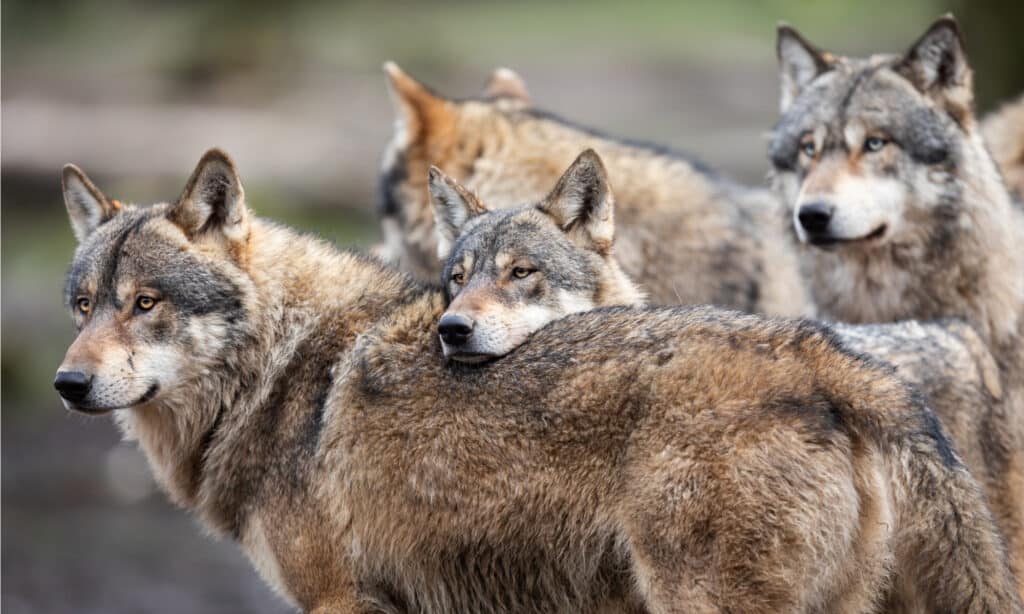Wolves are creatures that fascinate most people, and for good reason. Without wolves, we would never have a dog to play ball or snuggle on the couch. After all, every single dog on earth originated from wolves. It’s hard to believe, looking at some breeds out there! Wolves are beautiful, ferocious animals that live in bonded, family-oriented packs that have intrigued the young and old for centuries. Let’s dive right in and find out whether or not these noble beasts mate for life.
Do Wolves Mate for Life?

Wolves lick each other’s faces to greet a dominant member and to help clean each other off.
©Pat-s pictures/Shutterstock.com
Yes, most of the time, alpha wolves are monogamous and spend their lives with each other. They are the only two wolves in their pack that have breeding rights. The pack comprises grown pups and possibly some other close relatives. The pair of alphas are the only two to mate to keep the pack population under control because all except for the alphas are typically related. The two alphas hunt, sleep, groom, play, and mate together. They are seldom seen apart. However, if one of the alpha pairs dies, the other will choose another mate. Their status is “until death do them part.”
Mating
The alpha female comes into oestrus for a mere seven days from January through March. The alpha pair may go on “vacation” together at that time to be alone. They also don’t want to mate in front of their children’s prying eyes and constant needs. After they breed, the female will seek out the perfect spot for a den to give birth to her new pack members. This is always close to a water source, so she doesn’t have to go far to drink, which is vital to any nursing mama. When the female is pregnant, she becomes the boss of all bosses, and the pack works to ensure she has enough food and is well protected.
Pups
The alpha female’s reign over all continues once she has her pups. The alpha male brings her food, and the other members will bring her and the pups food and always let her enjoy the kill first if she leaves the den. As the pups are weaned and old enough to meet the pack, the female will bring them out to eat with the pack when she eats. The pack will help educate the little wolves and show them all the ropes to being great members.
Times When Wolves Might Not Mate for Life

Most wolves in a pack are related.
©Holly S Cannon/Shutterstock.com
Sometimes, the unexpected happens, and an alpha must pick another mate for the pack’s health. This may occur if one alpha dies. It might also happen if either alpha cannot reproduce or has created pups with health issues. Another time it could happen is when there is a significant change to the pack’s stability, and the numbers are too low. Sometimes, betas will mate or other ranks.
This would mean brothers and sisters or mother and brother mating, which isn’t optimal for aiding the pack. Sometimes, they must do what’s necessary so the pack does not die out. With wolves being heavily hunted, trapped, and losing their habitats, they must keep from becoming extinct.
Interesting Facts About Wolves

Wolves all play a role in their pack.
©AB Photographie/Shutterstock.com
- Wolves do not mate for the first time until they are two or three years old.
- The red wolf is almost extinct, with less than 50 living in the coastal region of NC.
- Most wolf packs consist of four to 12 members.
- To secure their territory, wolves kill other large predators like coyotes, mountain lions, and other wolves.
- Wolves can hear a sound in the woods from six miles away
- The front paws of a wolf are more significant than the rear paws.
- Grey wolves, including their tail, measure four to six feet long.
- Wolves do not have a foveal pit, which aids them in focusing on prey from far distances.
- Wolves have over 200 million olfactory cells, which allows them to pick up scents from far away.
- The maximum speed at which a wolf can run is 35 miles per hour, but they are long-distance runners that wear down their prey.
- Wolves eat once a week as a pack. Their usual kills are caribou and deer if they’re lucky. One wolf can consume 20 pounds of meat in one sitting! The scraps also serve an important purpose for other animals with scarce prey.
- When going in for the kill, a wolf will leap up and grab the victim by the nose, throat, or rear to bring them down.
- Alpha wolves hold their tails high in the air, while the less dominant might even have their tails tucked between their legs.
- A pack of wolves can journey anywhere from 20 – 100 miles daily.
- A lone wolf may be a grown pup from one pack off to find their mate.
- Pack territories can be as large as 1,000 square miles, as seen with the Arctic wolves.
- Wolf pups cannot hear until they are three weeks old. They open their eyes for the first time between one and two weeks old.
- Only about 50% of wolf pups survive. Many adults do not live past five years old in the wild.
- Wolves prey on elderly, sick, or weak animals, which leaves the healthy, mature elk, deer, or caribou to continue.
- A single wolf howl can be heard for six miles.
The photo featured at the top of this post is © RamiroMarquezPhotos/iStock via Getty Images
Thank you for reading! Have some feedback for us? Contact the AZ Animals editorial team.






